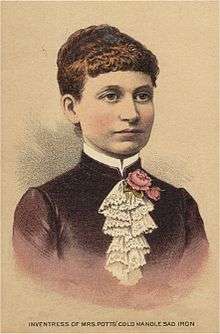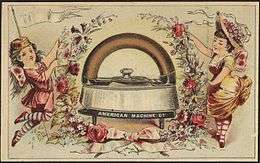Mary Florence Potts
Mary Florence Potts (née Webber; September 1850 – 1922) was an American businessperson and inventor. She invented clothes irons with detachable wooden handles that became prominent throughout North America and the European continent. She termed herself an "inventress".
Mary Florence Potts | |
|---|---|
 Mary Florence Potts, ca. 1895 | |
| Born | Mary Florence Webber September 1850 |
| Died | July 1922 (aged 71) |
| Nationality | American |
| Occupation | businessperson and inventor |
| Spouse(s) | Joseph Potts |
| Children | 6 |
Early life
Potts was born in Iowa and gave her birth date as September 1850 in the 1905 New Jersey Census[1] and September 1851 in the 1900 United States Federal Census.[2] Her parents were Jacob Hanec Webber (from Pennsylvania) and Anna Nancy McGinley (from Ohio). Her exact birth date is unknown and recorded by various sources as from November 1, 1850, to 1853.[3][4]
Mid life and career


Potts is associated with improvements to the sadiron that she made from the age of 19. The old English word of sad before the "iron" meant heavy, dense, and solid.[5] Potts's patented double-pointed shaped clothes iron was made of hollow rather than solid metal.[6] The flat iron's bottom was of thick iron and the sides were thin sheets of iron. The hollow iron was poured and filled with material that was a poor conductor of heat, such as cement or clay.[7] Since her father was a plasterer by trade she experimented on filling some with a type of plaster of Paris.[7] The advantage of these materials was that they did not radiate heat up like the predecessor old-style conventional solid metal clothes irons.[7] Her patent claimed it retained heat longer and as a result would need less reheating.[7]
The conventional solid metal clothes iron of the 19th century weighed around 5 pounds (2.3 kg) to 10 pounds (4.5 kg) and had to be heated on a stove. It was so hot, that often a rag or thick cloth mitt was utilized to touch the metal handle to prevent burning the fingers. Once this all-metal iron cooled down, the ironing job at hand had to stop until it was reheated. The advantage of Potts's system was that there was always a waiting heated base ready to be switched out with the used cooled base, so the ironing could continue immediately.[8][9]
The most pronounced feature of Potts's clothes iron was a detachable rounded wooden handle. That allowed the iron base to be placed on a heated stovetop and the handle removed at that time to stay away and cool while the base heated up.[10] This prevented burned fingers, that often happened with the conventional all-solid-metal clothes iron of the nineteenth century.[11] The handle and bases were designed standard and could be easily reattached to various sizes after they were heated for little delay in ironing.[12][13]
Initially, Potts sold her innovative clothes iron, but later it was franchised out and manufactured by the American Machine Company of Philadelphia.[9] This company marketed the clothes iron in a kit package that contained one wooden handle mechanism that attached to three iron bases.[7] The handle could only connect to Potts's iron bases, in effect tripling sales of these clothes irons over that of conventional solid metal irons.[14]
Potts's double-pointed clothes iron became a standard household appliance widely used throughout North America and the European continent.[6][15] Because of its shape, it was more efficient in pressing clothes as it could be operated in both directions.[12] Potts's patented invention of her various styles of clothes irons were the most popular ever used.[3][12] The 1876 Philadelphia Exposition World's Fair displayed Potts's cold-handled sadiron and it was popular through the century.[4][16] Her cold handle innovative clothes iron was also a favorite item at the 1893 Chicago World's Fair.[17]
Family
She married Joseph Potts and they had a family of six children.[12] She died in New Jersey in 1922.
Patents
She was awarded three United States patents.[4] Potts had two patents for metal flat iron improvements in 1871–1872.[18] In addition she held an invention for a medical device that her husband helped make.[12] Potts termed herself as an "inventress" — a Victorian expression.[3]
Legacy
Potts's innovation of a removable handle mechanism of 1871 was later implemented by Gillette in 1901 – some thirty years later. Gillette's application was a removable disposable blade and reinsertion of a sharp blade. This was a spin-off of Potts's removable cooled clothes iron base that could be reattached to a preheated base ready to go for ironing. This concept presaged the twentieth-century construction industry concept for portable hand tools with removable exhausted battery packs that can be reattached to fully charged batteries.[14]
References
- New Jersey, State Census, 1905
- 1900 United States Federal Census
- Amram 1998, p. 106.
- Gale 2007, p. 1536.
- Williams 2017, p. 7.
- Gillies, Scott (April 22, 2009). "Iron designs had a few wrinkles in early days". Ingersoll Times newspaper online. Sun Media Community Newspapers. Retrieved May 13, 2017.
- US Patent Office 1880, p. 250.
- Williams 2017, p. 7-8.
- Ladd, Marsha (January 11, 2014). "Mrs. Potts's sad iron". Retrieved May 14, 2017.
- Williams 2017, p. 8.
- "Mrs. Potts wooden handle iron". Indiana Gazette. Indiana, Pennsylvania. January 21, 1987. p. 10 – via newspapers.com

- "Inventors". Women in World History. Gale Research Inc. 2002. Retrieved May 12, 2017.
Potts – American inventor of the most popular irons ever used.
- Zierdt-Warshaw 2000, p. 254.
- Williams 2017, p. 9.
- Marks, Dorothy (August 25, 1976). "Centennial Hailed Women". Lubbock Avalanche-Journal. Lubbock, Texas. p. 73 – via newspapers.com

- Reed Business 1984, p. 11.
- "A Visit with Mrs. Potts". Costumed Interpretations. Ellie Presents. Retrieved May 13, 2017.
- "Patents for Mary Florence Potts". Directory of American Tool and Machinery Patents. Datamp. 2017. Retrieved May 13, 2017.
Bibliography
- Amram, Fred M. B. (1998). "Women of Mettle". FAMILY Magazines Publishing. ISBN 978-1-351-98695-3.
... most popular irons ...
Cite magazine requires|magazine=(help)CS1 maint: ref=harv (link)
- Gale (2007). Dictionary of Women Worldwide. Thomson Gale. ISBN 978-0-7876-7585-1.CS1 maint: ref=harv (link)
- Reed Business (24 May 1984). New Scientist. Reed Business Information.CS1 maint: ref=harv (link)
- Williams, Robert Jr and Helena (21 April 2017). Vintage Marketing. Palgrave Macmillan US. ISBN 978-1-137-38721-9.CS1 maint: ref=harv (link)
- US Patent Office (1880). Drawings of Patents.CS1 maint: ref=harv (link)
- Zierdt-Warshaw, Linda (1 January 2000). Women in Technology. ABC-CLIO. ISBN 978-1-57607-072-7.CS1 maint: ref=harv (link)